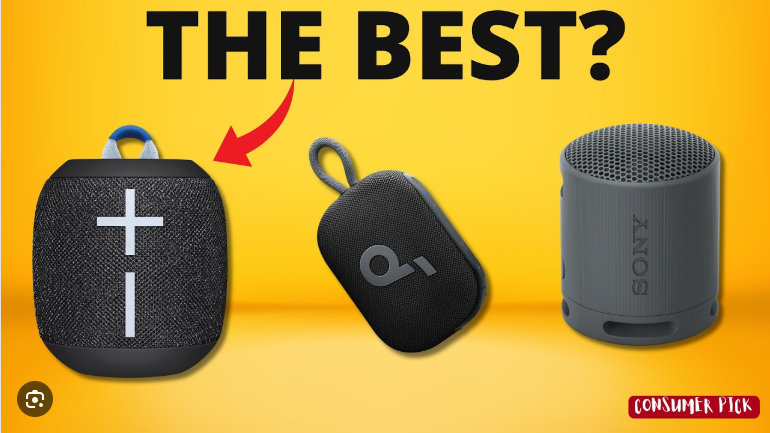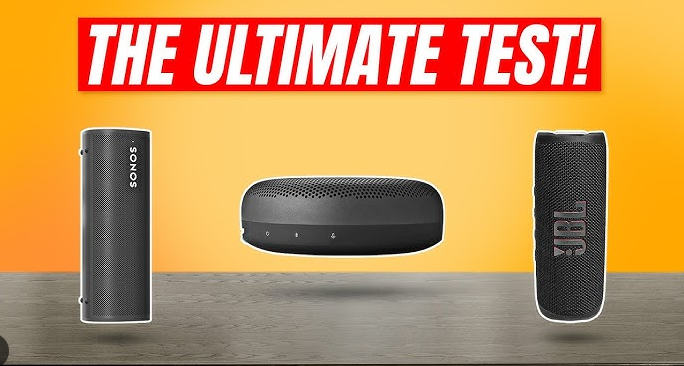When choosing a Bluetooth speaker, the debate of Sony vs Anker Bluetooth speaker often comes up due to their distinct approaches to audio quality, durability, and value. Sony is renowned for its premium sound and innovative features, while Anker’s Soundcore line excels in affordability and robust performance. In this comprehensive comparison, we’ll evaluate Sony and Anker portable Bluetooth speakers based on sound quality, durability, battery life, portability, and features. We’ll also cover Bluetooth speaker setup, maintenance, troubleshooting, and safety to help you decide which brand suits your needs. This best Bluetooth speaker guide will clarify the Sony vs Anker Bluetooth speaker debate. For more audio insights, visit our Bluetooth speaker guide.
Sony vs Anker Bluetooth Speaker: Brand Overview
Sony is a pioneer in audio technology, known for high-fidelity sound, advanced codecs like LDAC, and durable designs with features like Extra Bass and party lighting. Sony speakers, such as the ULT Field 7, cater to audiophiles and party-goers, though they often come at a premium price. Anker Soundcore, established in 2011, focuses on value-driven audio with BassUp technology, long battery life, and affordable prices. Models like the Soundcore Boom 2 offer impressive performance for budget-conscious buyers. Both brands excel in different areas, making the Sony vs Anker Bluetooth speaker comparison a matter of priorities. Let’s break down the key factors.
Comparing Sony vs Anker Bluetooth Speakers
We’ll compare Sony and Anker portable Bluetooth speakers across critical categories, using popular 2025 models like the Sony ULT Field 1, Sony SRS-XB100, Anker Soundcore Boom 2, and Soundcore Motion 300.
1. Sound Quality
Sony: Sony speakers are known for balanced sound profiles with strong bass, often enhanced by Extra Bass or ULT modes. The Sony ULT Field 1 (30W) uses a Sound Diffusion Processor for a wide stereo image, ideal for outdoor use. The SRS-XB100 offers a full-range driver and passive radiator for robust sound in a compact package, with clear mids and highs. Sony’s LDAC codec (supported by models like the ULT Field 1) allows high-resolution audio streaming up to 990kbps, providing superior clarity for Android users. However, some users note Sony’s bass can overpower mids in bass-heavy genres. Strength: Balanced sound, LDAC support.
Anker Soundcore: Anker speakers prioritize powerful bass via BassUp technology, with models like the Soundcore Boom 2 (80W) delivering punchy lows and clear highs. The Motion 300 (30W) uses two full-range drivers for stereo sound, enhanced by spatial audio processing for a taller soundstage, ideal for indoor use. Anker’s sound is impressive for the price but may lack the finesse of Sony’s high-end models, with occasional distortion at max volume. The Soundcore app offers customizable EQs, giving users more control than Sony’s preset modes. Strength: Strong bass, customizable EQ.
Verdict: Sony edges out for audiophiles due to LDAC and balanced sound, while Anker excels for bass lovers and budget buyers seeking customizable audio.
2. Durability
Sony: Sony speakers are built for rugged environments, with many models featuring IP67 ratings for water and dust resistance. The Sony ULT Field 1 adds MIL-STD 810H shock resistance, making it ideal for outdoor adventures like camping or beach trips. The SRS-XB100 is also IP67-rated, ensuring durability in harsh conditions. Sony’s designs are sturdy but may lack dustproofing in some older models like the SRS-XB12. Strength: Rugged build, shock resistance.
Anker Soundcore: Anker speakers typically feature IPX7 waterproofing, as seen in the Soundcore Boom 2 and Motion 300, but lack dustproofing, making them less suited for sandy environments. They’re durable for poolside or shower use but not as rugged as Sony’s shock-resistant models. Anker’s builds, like the Motion 300’s metal grille, feel premium but may not withstand extreme outdoor conditions as well as Sony. Strength: Waterproof, solid build.
Verdict: Sony wins for outdoor durability due to IP67 ratings and shock resistance, while Anker is sufficient for casual outdoor use but lacks dustproofing.
3. Battery Life
Sony: Sony speakers offer solid battery life, with the ULT Field 1 providing up to 12 hours (6 hours at max volume) and the SRS-XB100 offering 16 hours. Battery performance varies with volume and features like LED lights (ULT Field 7), which can reduce playtime. Sony’s efficient Bluetooth 5.3 helps maintain consistent battery life. Strength: Reliable battery life.
Anker Soundcore: Anker excels in battery life, with the Soundcore Boom 2 and Soundcore 3 offering up to 24 hours of playtime, and the Motion 300 providing 13 hours at moderate volumes. Anker’s batteries perform well even at higher volumes, though features like BassUp or LED lights (Boom 2) can reduce playtime. Strength: Exceptional battery life.
Verdict: Anker takes the lead with longer battery life, especially for budget models, while Sony’s battery performance is reliable but shorter in high-volume scenarios.
4. Portability
Sony: Sony offers a range of sizes, from the ultra-compact SRS-XB100 (3 x 3.74 inches, 0.6 pounds) to the larger ULT Field 7 (20.1 x 8.8 inches, 13.9 pounds). The ULT Field 1 (8.1 x 3.0 x 3.0 inches, 1.4 pounds) is highly portable with a strap for easy carrying. Sony’s compact models are ideal for travel, while larger ones suit stationary use. Strength: Compact options for travel.
Anker Soundcore: Anker’s lineup includes portable options like the Soundcore Mini (2.8 x 3.33 inches, 0.5 pounds) and Motion 300 (7.9 x 3.6 x 2.2 inches, 1.76 pounds). The Boom 2 (12.2 x 7.2 x 4.9 inches, 3.75 pounds) is less portable but includes a handle. Anker’s designs prioritize lightweight builds, though larger models are bulkier than Sony’s compact offerings. Strength: Lightweight budget models.
Verdict: Sony offers more compact, travel-friendly options, while Anker’s larger models are less portable but still manageable.
5. Features and Connectivity
Sony: Sony speakers support Bluetooth 5.3 for stable connections and often include LDAC for high-resolution audio. Models like the ULT Field 7 offer party features like LED lights, mic/guitar inputs, and Stereo Pair/Party Connect for pairing multiple units. The Sony Music Center app provides limited EQ customization but controls lighting and modes. Some models, like the SRS-XB100, include hands-free calling. Strength: Advanced codecs, party features.
Anker Soundcore: Anker uses Bluetooth 5.0/5.3 and supports LDAC in premium models like the Motion X600. The Soundcore app offers robust EQ customization, TWS pairing for stereo sound, and light show controls (Boom 2). Features like spatial audio (Motion X600) and powerbank functionality (Boom 2 Plus) add versatility, but Anker lacks mic/guitar inputs. Strength: Customizable EQ, spatial audio.
Verdict: Anker offers more app-based customization, while Sony excels in party features and advanced codec support.

Top Sony vs Anker Bluetooth Speaker Models
Here are standout models from each brand in 2025, ideal for various use cases:
- Sony ULT Field 1 ($89.99): Compact (8.1 x 3.0 x 3.0 inches, 1.4 pounds), 30W output, IP67 rating with shock resistance, 12-hour battery life, LDAC support. Best for outdoor durability and balanced sound.
- Sony SRS-XB100 ($50): Ultra-portable (3 x 3.74 inches, 0.6 pounds), 5W output, IP67 rating, 16-hour battery life, stereo pairing. Ideal for travel and budget buyers.
- Anker Soundcore Boom 2 ($129.99): Mid-size (12.2 x 7.2 x 4.9 inches, 3.75 pounds), 80W output, IPX7 rating, 24-hour battery life, RGB lights, TWS pairing. Great for parties and bass-heavy music.
- Anker Soundcore Motion 300 ($79.99): Compact (7.9 x 3.6 x 2.2 inches, 1.76 pounds), 30W output, IPX7 rating, 13-hour battery life, spatial audio. Perfect for indoor use and portability.
Bluetooth Speaker Setup for Sony and Anker
Proper Bluetooth speaker setup ensures optimal performance for both brands:
- Charge Fully: Charge using the provided USB-C cable. Sony’s SRS-XB100 takes 4 hours for 16 hours of playtime; Anker’s Boom 2 takes 3 hours for 24 hours.
- Enter Pairing Mode: Press the Bluetooth button (Sony: often on top; Anker: side or top) to activate pairing, indicated by a flashing LED.
- Connect to Device: Enable Bluetooth on your phone (Settings > Bluetooth) and select the speaker. Sony’s ULT Field 1 supports NFC for quick pairing; Anker’s Motion 300 uses Bluetooth 5.3 for a 66-foot range.
- Optimize Placement: Place centrally for 360-degree models (Sony SRS-XB100) or angle toward listeners for directional models (Anker Motion 300). Avoid walls to prevent boomy bass.
- Use Apps: Sony Music Center offers light and mode control; Soundcore app provides EQ customization and TWS pairing.
Bluetooth Speaker Troubleshooting
Common issues can affect both Sony and Anker speakers. Here are Bluetooth speaker troubleshooting tips:
- Connection Issues: Ensure pairing mode is active and the speaker is within 33–100 feet. Forget the device in Bluetooth settings and re-pair. Reset by holding power and Bluetooth buttons for 5–20 seconds (check manual).
- No Sound: Confirm the speaker is paired, unmuted, and volume is up. Check for grille debris and clean with a soft brush or rinse IPX7/IP67 models.
- Distortion: Lower volume to 70–80% to avoid driver strain. Adjust EQ in the Soundcore app or disable Sony’s ULT mode for cleaner sound.
- Battery Issues: Charge fully and avoid overcharging. If battery life is poor, contact support, as warranties (1–2 years) may cover replacements.
Bluetooth Speaker Cleaning and Maintenance Tips
Proper Bluetooth speaker cleaning and maintenance prevent damage and ensure longevity:
- Clean the Exterior: Wipe with a soft, dry cloth. For dirt or sand, use a damp cloth with mild soap, avoiding harsh chemicals.
- Clear the Grille: Remove debris with a soft brush. Rinse IPX7/IP67-rated models (Sony ULT Field 1, Soundcore Boom 2) under fresh water after beach use and dry thoroughly.
- Protect from Elements: Store in a case to shield from dust or UV exposure, especially for Anker’s non-dustproof models like the Boom 2 Plus.
- Battery Care: Charge every 2–3 months if unused to prevent degradation. Avoid overcharging by unplugging once full.
- Check Ports: Keep USB-C ports clean using compressed air or a small brush.
For more maintenance tips, visit our guide at bluetoothspeakerusa.com.
Bluetooth Speaker Safety Tips
Follow these Bluetooth speaker safety tips to protect your Sony or Anker speaker:
- Check IP Rating: Use IP67-rated Sony models like the ULT Field 1 for outdoor settings; avoid exposing Anker’s IPX7 models like the Motion 300 to dust or sand.
- Avoid Overheating: Keep speakers away from direct sunlight or heat sources to prevent battery or circuit damage.
- Use Proper Charging: Use the manufacturer’s USB-C cable to avoid electrical issues.
- Secure Placement: Place on stable surfaces to prevent falls, especially for heavier models like the Sony ULT Field 7.

Sony vs Anker Bluetooth Speaker: Which Should You Choose?
The Sony vs Anker Bluetooth speaker decision depends on your priorities:
- Choose Sony If: You prioritize durability (IP67 and shock resistance), high-resolution audio (LDAC), or party features like lights and mic inputs. Models like the ULT Field 1 ($89.99) or SRS-XB100 ($50) are ideal for outdoor use or budget buyers seeking balanced sound.
- Choose Anker If: You want affordability, long battery life, and customizable sound. The Soundcore Boom 2 ($129.99) excels for parties, while the Motion 300 ($79.99) is great for indoor use and portability.
Conclusion: Sony vs Anker Bluetooth Speaker
In the Sony vs Anker Bluetooth speaker debate, both brands offer compelling options for 2025. Sony shines with rugged durability, LDAC support, and balanced sound, making it ideal for outdoor enthusiasts and audiophiles. Anker’s Soundcore line delivers exceptional value, longer battery life, and customizable audio, perfect for budget-conscious users or bass lovers. By following our Bluetooth speaker setup, cleaning, maintenance, and safety tips, you can ensure your speaker performs at its best. Ready to pick the best Bluetooth speaker for you? Explore our best Bluetooth speaker guide at bluetoothspeakerusa.com for more reviews and expert advice.